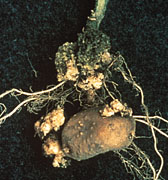Following the discovery of black wart of potato on Prince Edward Island, Canada on October 24, 2000 the Canadian Food Inspection Agency developed a three-year work plan with the United States Department of Agriculture that was to mitigate the spread of this important disease of potatoes.
 |
|
This pathogen is a funguslike organism that was eradicated from the US in 1982. Any re-introduction of this pathogen could be devastating to the potato industry in the US because, once introduced, it is capable of surviving for up to 40 years in the soil. An agency of the USDA, the Animal and Plant Health Inspection Service (APHIS), has established strict policies restricting the movement of table stock potatoes from P.E.I. to the U.S. because the pathogen could be spread by infected tubers or infested soil. Table stock potatoes are the potatoes that are usually sold in grocery stores and used to make French fries. The USDA policies require that there can be no movement of seed potatoes (tuber pieces used for planting) from PEI to the US, that there must be phytosanitary certificates for seed potatoes (certifying that the potatoes are free of the disease), and that the origin of the table stock potatoes be certified. In this way, quarantines were being used by the USDA-APHIS to protect the important US potato industry.
The following recent news articles released by the Canadian Food Inspection Agency illustrate how serious this disease is considered to be and how seriously the control measures are being taken. The US and Canada are taking extraordinary measures to curb this threat to the potato industry in both countries.
POTATO WART DISEASE - CANADA (PRINCE EDWARD ISLAND)
Date: 4 Sep 2002
Source: Canadian Food Inspection Agency [edited]
Potato wart confirmed in a second field in Prince Edward Island
The Canadian Food Inspection Agency (CFIA) announced that potato wart [PW] disease, caused by the [soil-inhabiting] fungus (Synchytrium endobioticum), was found in a second field on Prince Edward Island (PEI). The infected field is considered a "contact" field due to its relation with the initial finding of PW in PEI in October 2000, and is located about 10 km from the original site. The CFIA confirmed the presence of PW in the second field on 3 Sep [2002], and took measures to mitigate the risk of spreading the disease immediately after it was first suspected on 30 Aug 2002. All affected land, machinery, and equipment were placed under an order prohibiting movement, and arrangements were made to have machinery and equipment cleaned and disinfected under CFIA supervision. Following the initial discovery of PW disease in a field of potatoes in New Annan, PEI, on 24 Oct 2000, the CFIA and the US Department of Agriculture (USDA) developed a 3 year work plan that includes movement restrictions on fields within a buffer area and, associated with the affected contact field, a series of surveillance activities and a certification process for potatoes from fields determined to be PW-free.
Under the terms of this work plan, fields planted with potatoes last year were inspected, and were found to be PW-free. Within another 2 years, if the weather conditions are conducive to expression of PW disease, the vast majority of PEI fields should be declared PW-free. No impact on trade due to the new find is expected, given the existence of the 3-year work plan.
The discovery of PW disease occurred during regular harvest inspection activities, in cooperation with local industry, under the established monitoring program of the 3 year work plan. Later this year, for the second consecutive year, more than 200 CFIA potato inspectors will be monitoring potato fields in PEI and conducting surveillance activities for PW. The potatoes from the affected field were intended for processing only and all harvested potatoes have been processed.
The CFIA is proceeding with the implementation of a buffer area surrounding the affected field and restricting potato and soil movement from the affected, buffer zone and contact fields associated with this new finding. These restrictions are necessary to contain PW disease and prevent any further spread domestically or to other trading partners. No potatoes at risk have [been] moved off of the island. PW is a quarantine pest, but it does not affect the safety of potatoes for consumption.
POTATO WART DISEASE - CANADA (PRINCE EDWARD ISLAND)
Source: Press release, Press Canadian Food Inspection Agency,
5 Sep 2002 [edited]
The Canadian Food Inspection Agency (CFIA) has announced the second detection this season of potato wart disease [PWD] in Prince Edward Island (PEI), following an earlier announcement of the first discovery on 4 Sep 2002.
The newly discovered infected field is located about 15-20 km east of the field where PWD was detected and announced yesterday. The CFIA is conducting an in-depth investigation of both recent findings, in cooperation with the PEI provincial government and the PEI Potato Board.
The CFIA is currently working under the terms of the 3-year Canada/US work plan. Only potatoes determined to be free of PWD will be certified as eligible to be shipped domestically or to the United States.
The latest finding of PWD was made during a routine CFIA post-harvest field inspection as required under the work plan. Potatoes from both of the affected fields were being harvested for processing only.
During the past 2 years 11,600 soil samples were analyzed, 8400 inspections were conducted, and over 7000 fields have been declared free of PWD. Officials from the US Department of Agriculture (USDA) are planning to visit PEI early next week to assess the situation.
